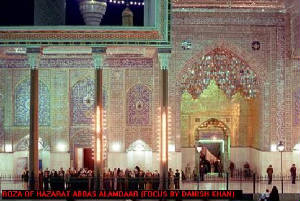|
PAKISTAN
INTRODUCTIONPakistan,
officially Islamic Republic of Pakistan, republic in South Asia, marking the area where South Asia converges with Southwest
Asia and Central Asia. The capital of Pakistan is Islamabad; Karachi is the country’s largest city.
The area
of present-day Pakistan was the cradle of the earliest known civilization of South Asia, the Indus Valley civilization (2500?-1700
bc). It was part of the Mughal Empire from 1526 until the 1700s, when it came under British rule. Pakistan gained independence
in August 1947. It initially comprised two parts, West Pakistan and East Pakistan, which were separated by about 1,600 km
(1,000 mi) of territory within India. In December 1971 East Pakistan seceded and became the independent republic of Bangladesh.
IILAND AND RESOURCESPakistan is bordered on the west by Iran, on the north and northwest by Afghanistan, on the northeast
by China, on the east and southeast by India, and on the south by the Arabian Sea. A panhandle of Afghanistan territory in
the northwest, the Wakhan Corridor, separates Pakistan and Tajikistan. The area of Pakistan is 796,095 sq km (307,374 sq mi),
not including the section of Jammu and Kashmir under its control. Jammu and Kashmir is a disputed territory located between
Pakistan and India. Pakistan controls a portion of the territory as Azad (Free) Kashmir and the Federally Administered Northern
Areas (FANA), while India controls a portion as the state of Jammu and Kashmir.
ANatural RegionsPakistan has great extremes
of elevation, reaching the highest point at the Himalayan peak of K2 (also known as Mount Godwin Austen) in the north and
the lowest point at the Arabian Sea coast in the south. The Indus River flows the length of Pakistan from north to south.
The Indus and its tributaries form a wide river valley with fertile plains in Punjab and Sind (Sindh) provinces. Pakistan
is mountainous in the north and west. Earthquakes are frequent, and occasionally severe, in the northern and western areas.
Much of Pakistan is a dry, sun-scorched region. To the west of the Indus are the rugged dry mountains of the Sulaiman
Range, which merge with the treeless Kirthar Range in the south. Farther west are the arid regions of the Baluchistan Plateau
and the Kharan Basin. A series of mostly barren low mountains and hills predominate in the western border areas. The Thar
Desert straddles the border with India in the southeast.
The country also possesses a variety of wetlands, with the glacial
lakes of the Himalayas, the mudflats of the Indus Valley plains, and the extensive coastal mangroves of the Indus River delta.
The wetland areas cover an estimated area of 7.8 million hectares (19.3 million acres).
BRiversThe Indus River is the
lifeline of Pakistan. Without the Indus and its tributaries, the land would have turned into a barren desert long ago. The
Indus originates in Tibet from the glacial streams of the Himalayas and enters Pakistan in the northeast. It runs generally
southwestward the entire length of Pakistan, about 2,900 km (1,800 mi), and empties into the Arabian Sea. The Indus and its
tributaries provide water to two-thirds of Pakistan. The principal tributaries of the Indus are the Sutlej, Beas, Chenab,
Ravi, and Jhelum rivers. In southwestern Punjab Province these rivers merge to form the Panjnad (“Five Rivers”),
which then merges with the Indus to form a mighty river. As the Indus approaches the Arabian Sea, it spreads out to form a
delta. Much of the delta is marshy and swampy. It includes 225,000 hectares (556,000 acres) of mangrove forests and swamps.
To the west of the delta is the seaport of Karachi; to the east the delta fans into the salt marshes known as the Rann of
Kutch.

ISLAM
IINTRODUCTIONIslam, one of the three major world religions,
along with Judaism and Christianity, that profess monotheism, or the belief in a single God. In the Arabic language, the word
Islam means "surrender" or "submission"-submission to the will of God. A follower of Islam is called a Muslim, which in Arabic
means "one who surrenders to God." The Arabic name for God, Allah, refers to the same God worshiped by Jews and Christians.
Islam’s central teaching is that there is only one all-powerful, all-knowing God, and this God created the universe.
This rigorous monotheism, as well as the Islamic teaching that all Muslims are equal before God, provides the basis for a
collective sense of loyalty to God that transcends class, race, nationality, and even differences in religious practice. Thus,
all Muslims belong to one community, the umma, irrespective of their ethnic or national background.
Within two centuries after its rise in the 7th century,
Islam spread from its original home in Arabia into Syria, Egypt, North Africa, and Spain to the west, and into Persia, India,
and, by the end of the 10th century, beyond to the east. In the following centuries, Islam also spread into Anatolia and the
Balkans to the north, and sub-Saharan Africa to the south. The Muslim community comprises about 1 billion followers on all
five continents, and Islam is the fastest-growing religion in the world. The most populous Muslim country is Indonesia, followed
by Pakistan and Bangladesh. Beyond the Middle East, large numbers of Muslims live in India, Nigeria, the former republics
of the Union of Soviet Socialist Republics (USSR), and China.
One of the reasons for the growth of the Muslim community
has been its openness to new members. Children born to Muslim parents are automatically considered Muslim. At any time, a
non-Muslim can convert to Islam by declaring himself or herself to be a Muslim. A person’s declaration of faith is sufficient
evidence of conversion to Islam and need not be confirmed by others or by religious authorities.
|
